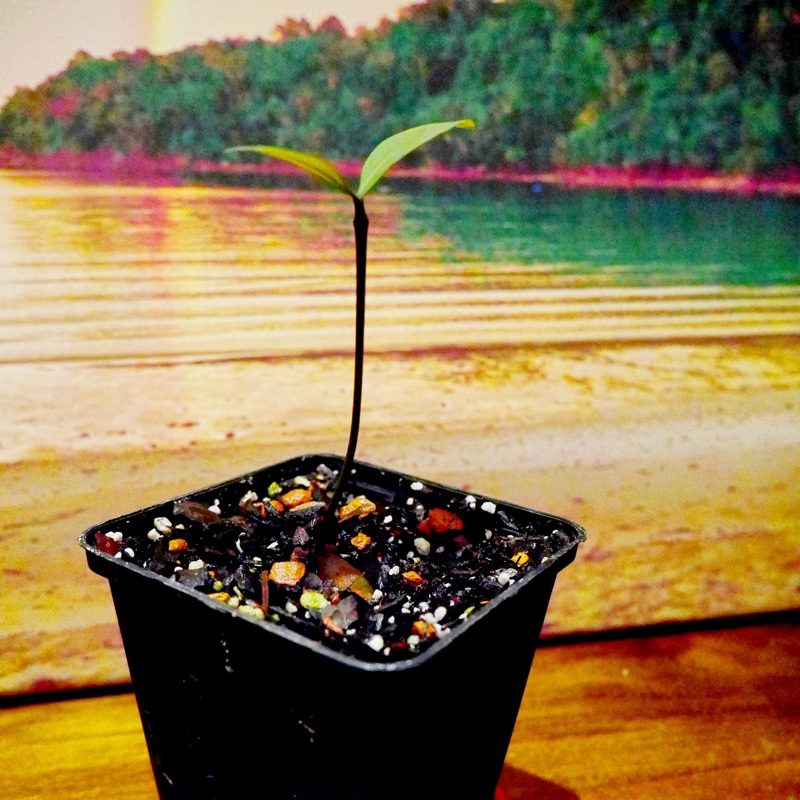
Garcinia Intermedia
Lemon Drop Mangosteen
The Mangosteen tree is a slow growing tropical tree, upright in habit, with a pyramid shaped crown, and difficult to grow anywhere that doesn't have a tropical climate. The flaky bark is nearly black and contains a very bitter latex. The leaves, which are pinkish colour when young, are dark green and glossy on the upper side, dull yellow-green on the underside.Flowers, which are 1 ½ -2 " across, can be male or hermaphrodite on the same tree. Male flowers are borne in clusters of three to nine at the branch tips. They are fleshy, green with red spots on the outsides and yellowish red on the inside. Hermaphrodite blooms are found at the tip of branchlets and are yellowish green edged with red and are short lived. fruit is round, dark purple to reddish purple, smooth and about 1 1/3 to 3 inches in diameter. The fruit - sometimes referred to as "queen of tropical fruit" - are round, about 3" dia., usually purple, with white, soft, juicy, sweet, slightly acidic flesh, that may contain seeds. This tree does not tolerate temperatures below 40 degrees F. (4 C.) or above 100 degrees F. (37 C.) and requires rainfall of at least 50" with no drought. Lemon Drop Mangosteen is a rare South American tropical fruit tree that bears small round yellow aromatic fruits with a sour taste, from about 2 years on a small bushy tree. Rare in cultivation in UK.
Contributed by @drnicko
-
Partial shade
-
Frequent watering
-
Not Frost hardy
-
Free draining and fertile
Common name
Lemon Drop Mangosteen
Latin name
Garcinia Intermedia
type
Fruiting tree
family
Clusiaceae
ph
5.5 - 6.8 Acid - Neutral
Plant & bloom calendar
-
Best time to plant
full grown dimensions
 5.00 M
6.50 M
5.00 M
6.50 M
Garcinia Intermedia
The Mangosteen tree is a slow growing tropical tree, upright in habit, with a pyramid shaped crown, and difficult to grow anywhere that doesn't have a tropical climate. The flaky bark is nearly black and contains a very bitter latex. The leaves, which are pinkish colour when young, are dark green and glossy on the upper side, dull yellow-green on the underside.Flowers, which are 1 ½ -2 " across, can be male or hermaphrodite on the same tree. Male flowers are borne in clusters of three to nine at the branch tips. They are fleshy, green with red spots on the outsides and yellowish red on the inside. Hermaphrodite blooms are found at the tip of branchlets and are yellowish green edged with red and are short lived. fruit is round, dark purple to reddish purple, smooth and about 1 1/3 to 3 inches in diameter. The fruit - sometimes referred to as "queen of tropical fruit" - are round, about 3" dia., usually purple, with white, soft, juicy, sweet, slightly acidic flesh, that may contain seeds. This tree does not tolerate temperatures below 40 degrees F. (4 C.) or above 100 degrees F. (37 C.) and requires rainfall of at least 50" with no drought. Lemon Drop Mangosteen is a rare South American tropical fruit tree that bears small round yellow aromatic fruits with a sour taste, from about 2 years on a small bushy tree. Rare in cultivation in UK.
Planting
From Early Spring TO Late Winter
Mangosteen is difficult to grow anywhere other than tropical areas. They need a specific temperature range of not lower than 40 deg. F (4 deg. C) and no higher than 100 deg. F (37 deg.C) and they also require a lot of water (50cms per year). Plant in a soil mix - sand, loam, or clay base, topsoil, and compost - in a shady area, in a greenhouse if not in a tropical area, and keep well watered so that the soil mix never dries out..
Propagating by seed
From Early Spring TO Late Winter
Seeds need to have been removed from the fruit for up to 5 days. Wrap the seeds in moistened paper towels and place in a container in the fridge to keep them cool and moist, then, when you are ready to plant the seed, soak them in water for 24 hours. Place the seed in the middle of a small pot with drainage holes in a mix of soil and compost, leaving a 1" gap at the top of the pot. Soak the compost thoroughly, and place the pot where it will get at least 12 hours of sunlight a day.Leave it in the pot for at least 30 days to germinate, keeping the compost moist.









